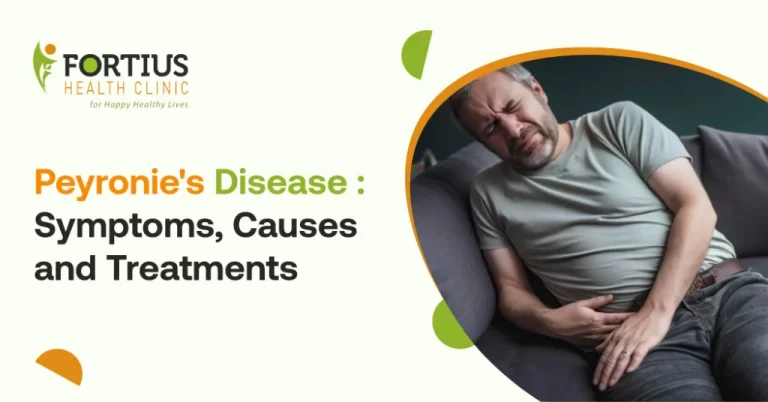
peyronie’s disease : Symptoms, Causes and Treatments
Peyronie disease (Penile curvature) is quite a common condition that affects 1 in 10 men. Men who do not treat Peyronie disease may even face worse symptoms like erectile dysfunction. It does not cause any damage to the body other than penis and erection. In some sporadic cases, Peyronie disease goes away without treatments. This blog lists the symptoms, causes, and cures for Peyronie.
What is Peyronie’s disease?
Peyronie’s disease is a condition where scar tissue called plaque is built under the skin of the penis. These fibrous scar tissues can cause a curved penis, which makes it difficult for intercourse, causing pain and erection problems.
Symptoms of Peyronie’s disease
Penile Curvature
The unusual curve of the penis during an erection is one of the distinguishing features and visible symptoms. This curvature may be upward, downward, or to either side, varying in severity from minor to severe.
Penile Pain
Many people who have Peyronie’s disease feel pain during their erections. Depending on where and how much scar tissue there is, this pain can range from slight discomfort to intense throbbing or stabbing sensations. Sexual activity or other activities that result in a penile erection can potentially cause pain.
Erectile Dysfunction (ED)
Erectile dysfunction is a condition that can result from Peyronie’s disease, making it challenging for those who have it to get or keep a solid erection. The usual mechanics of erection can be affected by scar tissue within the penile tissue, which can disrupt tissue expansion and blood flow.
Penile Shortening
Peyronie’s illness may occasionally result in a shorter or significantly smaller penis, especially while the patient is erect. This happens due to scar tissue growing, which might alter the penile tissues’ natural shape and elasticity.
Emotional Distress
The physical manifestations of Peyronie’s disease, including penile curvature and erectile dysfunction, can affect an individual’s psychological state and self-worth. Changes in sexual function and appearance can cause anxiety, sadness, or relationship stress in many people.
Penile Deformity
In addition to curvature, penile abnormalities caused by Peyronie’s disease might include indentations, constriction, or an hourglass-shaped appearance during an erection. The localized fibrosis and scarring in the penile tissue are the source of these abnormalities.
Causes of Peyronie’s Disease
Trauma or Injury
Penile trauma or injury is often the initial cause of Peyronie’s disease. This may be chronic (repeated microtrauma from specific sexual practices or activities) or acute (during sexual activity or accident). The trauma starts the process of aberrant scar tissue formation by causing localized inflammation and tissue damage.
Genetics
Some researchers have proven that genetics are connected with Peyronie’s disease. People who are predisposed to aberrant scar tissue or an accelerated healing response after injury may have specific genetic characteristics.
Abnormal Healing Response
In people with Peyronie’s disease, the penis’s repair process may become dysregulated following damage. Excessive deposition of collagen, a kind of protein, at the site of damage prevents normal tissue regeneration. Instead, it results in the creation of fibrous plaques or scar tissue within the penile shaft.
Connective Tissue Disorders
Suppose you are affected by some connective tissue illnesses, such as ailments that impact collagen metabolism or Dupuytren’s contracture. In that case, you have a high chance of developing scar tissue under the penis.
Inflammation in the Penis
The fibrotic (scar-forming) process in the penis begins and is sustained by the production of inflammatory cells and cytokines (chemical messengers) in response to damage or other triggers.
Age and Hormonal Factors
Men over 40 years of age mostly face Peyronie disease. But now, according to a report, men from 20 have reported more for Peyronie’s disease. Age-related variations in hormone levels or hormonal imbalances may also impact the course of the illness.
Can Peyronie’s disease heal itself?
Peyronie’s disease heals on its own in 13% of the men within 6- 15 months. If you have plaques, the doctor may recommend some medication or injections. If you have a severe condition, you will be advised to go under surgery
Diagnosis of Peyronie’s disease
A sexologist or urology specialist diagnoses Peyronie’s disease. The diagnosis is made by studying the patient’s medical history, physical examination, and imaging tests like ultrasounds. Penile curvature, plaque placement, size, and erectile function testing are important evaluations of diagnosis.
Treatment options for Peyronie’s disease
Medications
Oral medications like collagenase (Xiaflex), pentoxifylline, or calcium channel blockers may be prescribed to reduce plaque size or symptoms. However, none of these have been proven to work effectively in all men.
Surgery
In severe situations, surgical techniques such as plaque incision/excision, penile implants, or grafting may be explored to rectify curvature and restore function.
Shockwave therapy
In this process, high-energy shock waves are used to enhance blood flow and disintegrate plaque in the penis. However, this method has shown limited results and is also controversial.
Injections
Some suggest injections. Then, you need to visit a doctor within 1-3 days. They may give collagenase injections directly into plaques, which can break down scar tissue and improve curvature.
How to Get Rid of Curvature from Peyronie’s Disease at Home?
While Peyronie’s disease often requires medical intervention, some home remedies can help manage the condition and reduce curvature. Let’s explore a few methods you can try in non-severe cases. They are,
- Gentle Stretching Exercises
- Penile Traction Therapy
- Vitamin E and Herbal Supplements
Gentle Stretching Exercises
Performing regular, gentle stretching exercises can help improve flexibility. You can try stretching the penis in the opposite direction of the curve for a few minutes each day. Ensure you’re applying minimal force to avoid further damage. Consistency is key, but be cautious not to overstretch.
Penile Traction Therapy
A penile traction device applies gentle, consistent pressure to help straighten the penis over time. Many men have seen gradual improvement by using these devices regularly. Follow the instructions carefully and use the device under medical guidance for the best results.
Vitamin E and Herbal Supplements
Some studies suggest that vitamin E and supplements like CoQ10 or bromelain may help reduce the plaque buildup that causes curvature. Though results vary, these natural remedies are often recommended to support overall penile health.
Always consult with a healthcare provider to ensure these methods are appropriate for your condition.
Takeaway
Peyronie disease is a non-deadly condition affecting the penis. Consult with a sexologist or urology specialist to find out the cause and get a cure. Leaving Peyronie’s disease non-treated can cause anxiety, stress, penis pain and worse pain during erection.
FAQs
Getting rid of fibrous plaque at home is challenging and typically requires medical intervention. Some suggest gentle stretching exercises and penile traction therapy may help. However, these methods should be approached cautiously, as improper techniques can worsen the condition. Consulting a healthcare provider for tailored treatment is recommended.
Curing penile curvature naturally is not straightforward. While some exercises, like gentle stretching or traction therapy, may help, they should be done under medical supervision. Attempting to straighten the penis without professional guidance can lead to injury or worsening of the curvature, making expert consultation crucial.
Peyronie’s disease is not deadly, but it can significantly impact quality of life. The condition involves the development of fibrous scar tissue in the penis, leading to painful erections and difficulties with sexual intercourse. While it is not life-threatening, it can cause emotional distress and relationship issues.
Peyronie's pain often feels like a sharp or aching sensation in the penis, particularly during erections or sexual activity. The pain can vary in intensity and may be accompanied by discomfort or tenderness in the affected areas. This pain can significantly affect sexual function and overall well-being.
Peyronie’s disease can affect size indirectly. The curvature caused by scar tissue may lead to a perceived reduction in length or girth during erections. Additionally, treatments for Peyronie’s disease, such as surgery, can also impact penile size, either positively or negatively, depending on the procedure.
Scar tissue in the penile shaft is primarily caused by trauma or injury, which can occur during sexual activity, medical procedures, or accidents. Other factors include genetic predisposition, certain medical conditions, and chronic inflammation. Peyronie’s disease specifically involves the formation of fibrous plaques in the penis.
Yes, it is possible to have Peyronie's disease without a noticeable curve. Some men may experience plaque buildup and associated pain without significant curvature. This condition can still lead to erectile dysfunction or discomfort during sexual activity, highlighting the importance of seeking medical evaluation even in the absence of a curve.
Peyronie’s disease can affect ejaculation, though this varies among individuals. Some men may experience pain during ejaculation or changes in the sensation. While Peyronie's primarily impacts the curvature and erection quality, any associated pain or discomfort can indirectly affect sexual performance and satisfaction.






